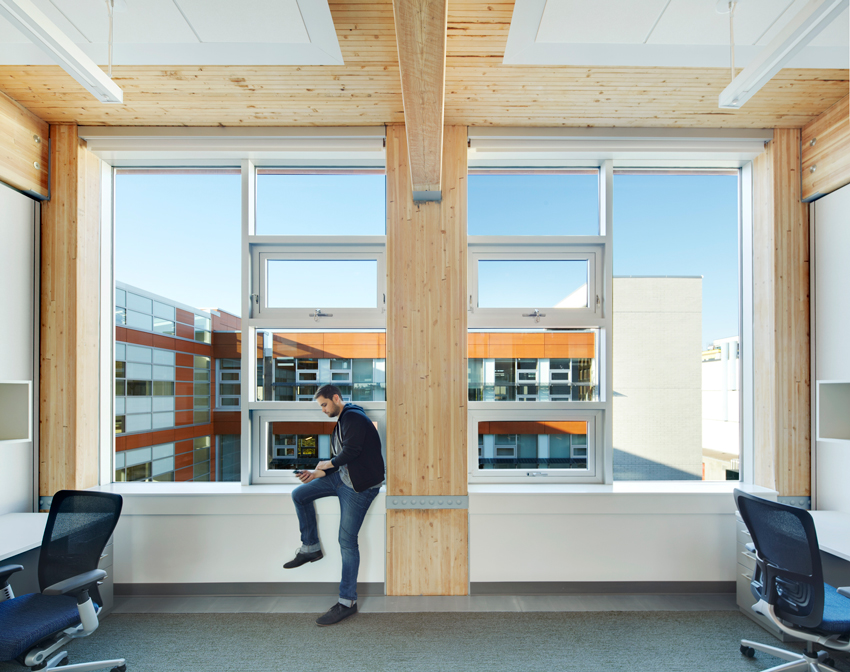Building Resilience: Expanding the Concept of Sustainability
Resilience, Longevity, and Green Building
While resilient design and green building objectives do sometimes conflict—e.g., redundant systems that provide greater structural performance may increase environmental impact—they share many objectives.
For example, some experts have proposed that resilience objectives include the use of low carbon-input materials with low embodied energy, such as wood—which makes sense, since even the best designed community is likely to experience structural loss in a major disaster and need to rebuild.11
Durability has also long been a tenet of green building and is likewise promoted in the context of resilience. However, despite many examples of wood buildings that have stood for centuries, wood has a perception issue when it comes to longevity. A report from research organization Dovetail Partners put it this way: “Despite a pervasive perception that the useful life of wood structures is lower than buildings of other materials, there is no meaningful relationship between the type of structural material and average service life.” The report added that “Current indices of the useful lives of various products allocate lower useful lives to wood than other materials without any basis for any of the chosen values.”
Supporting this conclusion, a study of buildings demolished in Minnesota found that most were demolished because of changing land values, changing tastes and needs, and lack of maintenance of non-structural components.12 In fact, wood buildings in the study were typically the oldest; the majority were older than 75 years. In contrast, more than half the concrete buildings fell into the 26-to-50-year category, and 80 percent of the steel buildings demolished were less than 50 years old. Overall, the fact that wood buildings had the longest lifespans shows that wood structural systems are fully capable of meeting a building’s longevity expectations.
Although adaptability from a resilience perspective most often means climate change adaptation, the fact that a wood structure is easily adapted with basic construction tools could contribute to faster recovery in the aftermath of disaster. The Resilient Design Institute also includes the use of locally available, renewable or reclaimed resources among its design principles, which favors wood use.
Performance-Based Design and Life-Cycle Assessment
Although the concept of ‘designing for resilience’ continues to evolve, a number of principles have been put forth by architects and engineers, as well as city planners and others involved in the design of buildings.
In a 2014 presentation at Greenbuild, for example, structural engineer Erik Kneer, SE, LEED AP BD+C, discussed the benefits of incorporating performance-based design (PBD) and the science of hazard loss estimation with a project’s environmental life-cycle assessment (LCA).13
“The stated intent of the building code is to prevent against major structural failure and loss of life, but not to limit damage or maintain function. Therefore, a code-based building is essentially a disposable building,” he said. “If we design a code-based LEED Platinum building and put it on top of an earthquake fault, and we haven’t considered and evaluated its life-cycle performance from those earthquake risks, I don’t think we can call the building sustainable. We need to protect the environmental and economic investment in our buildings.”
Described in “A Framework for the Integration of Performance-Based Design and Life Cycle Assessment to Design Sustainable Structures,” the marriage of PBD and LCA seeks to achieve a more comprehensive version of sustainability that includes a balance between social, economic, and environmental factors—often referred to as the “triple bottom line.”
PBD, where decisions are based on desired performance outcomes, is an alternative to the prescriptive approach of satisfying requirements prescribed in a building code for the structure to be deemed safe. Although the IBC contains many performance aspects (e.g., high risk category buildings are expected to perform better than lower risks category buildings), the concept of PBD generally refers to performance above code minimums or the use of alternative methods of design than those described in the building code. Whether a project is targeting code minimums or higher performance objectives, the approach for a wood building design involves the use of standards, such as the NDS and SDPWS.
Life-cycle assessment is a method for measuring the environmental impacts of materials, assemblies, or buildings over their entire life cycles, from extraction or harvest of raw materials through manufacturing, transportation, installation, use, maintenance, and disposal or recycling. It allows building designers to compare alternate designs based on their environmental impacts and make informed choices about the materials they use.
As with PBD, LCA is an alternative to the traditional prescriptive-based approach to material selection, but in the context of environmental instead of structural performance. An example would be specifying a material based on its actual environmental impacts instead of assuming that a product with recycled content is automatically better for the environment without considering its manufacturing process.
Put briefly, a mix of the two involves working to identify a design solution that meets engineering, societal, environmental, and economic performance objectives.
For many applications, that solution may well be a wood structure. In terms of engineering performance, this course includes several examples of buildings that perform beyond code minimums. LCA studies have also consistently shown that wood outperforms other building materials in environmental impact categories that include embodied energy, air and water pollution, and carbon footprint.14 Societal performance, which could be anything from corporate citizenship to business ethics, could be achieved in part through the use of a renewable resource from sustainably managed forests, and wood’s cost effectiveness could be the factor that allows a project with high engineering and environmental performance goals to pencil out.

Credit: Lend Lease
Made from CLT, the four-story Candlewood Suites Hotel at Redstone Arsenal, Alabama, had to meet Anti-Terrorism and Force Protection standards required for every structure built on a U.S. military base. Extensive engineering analysis was used to determine compliance with blast-resistance criteria.










